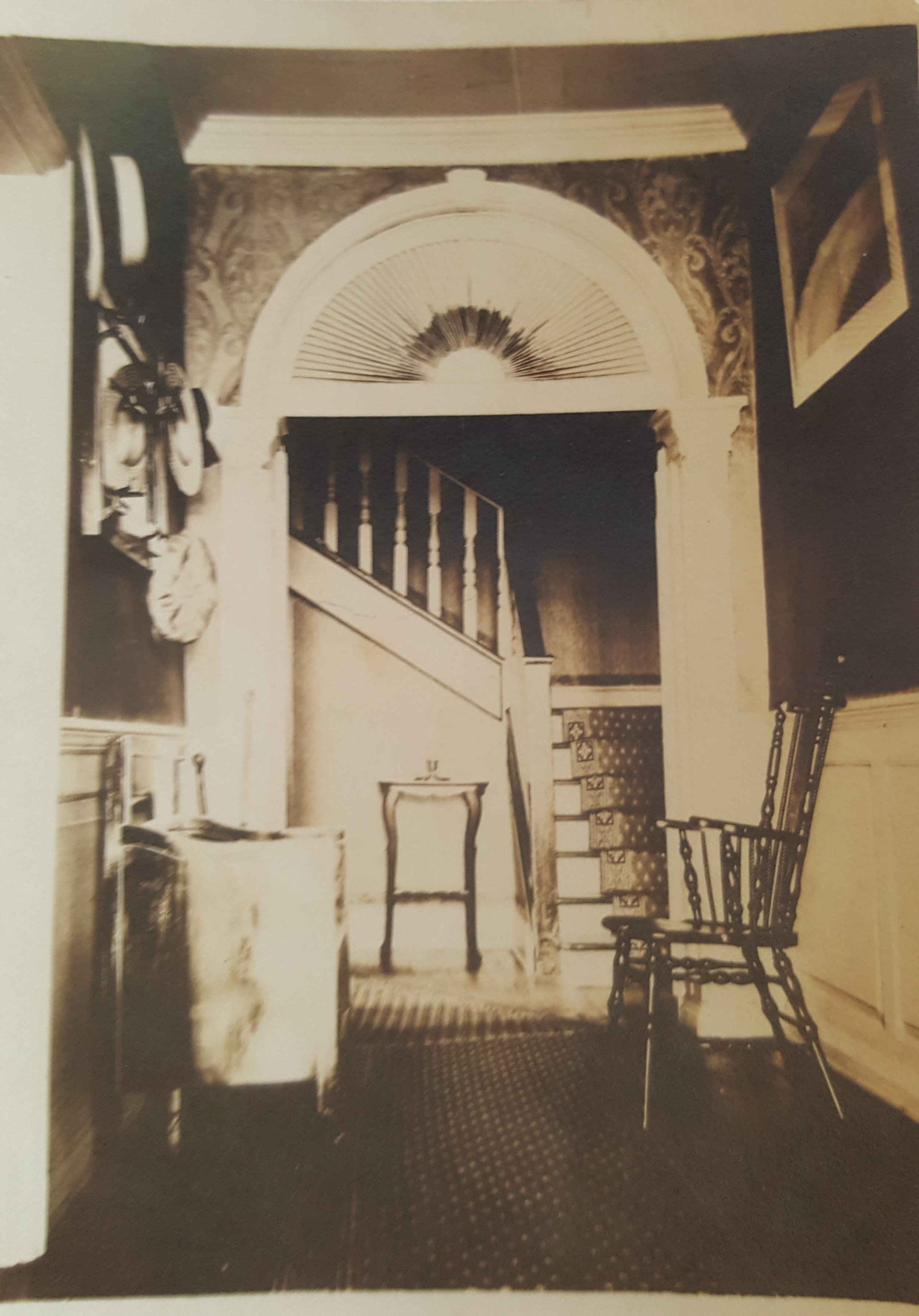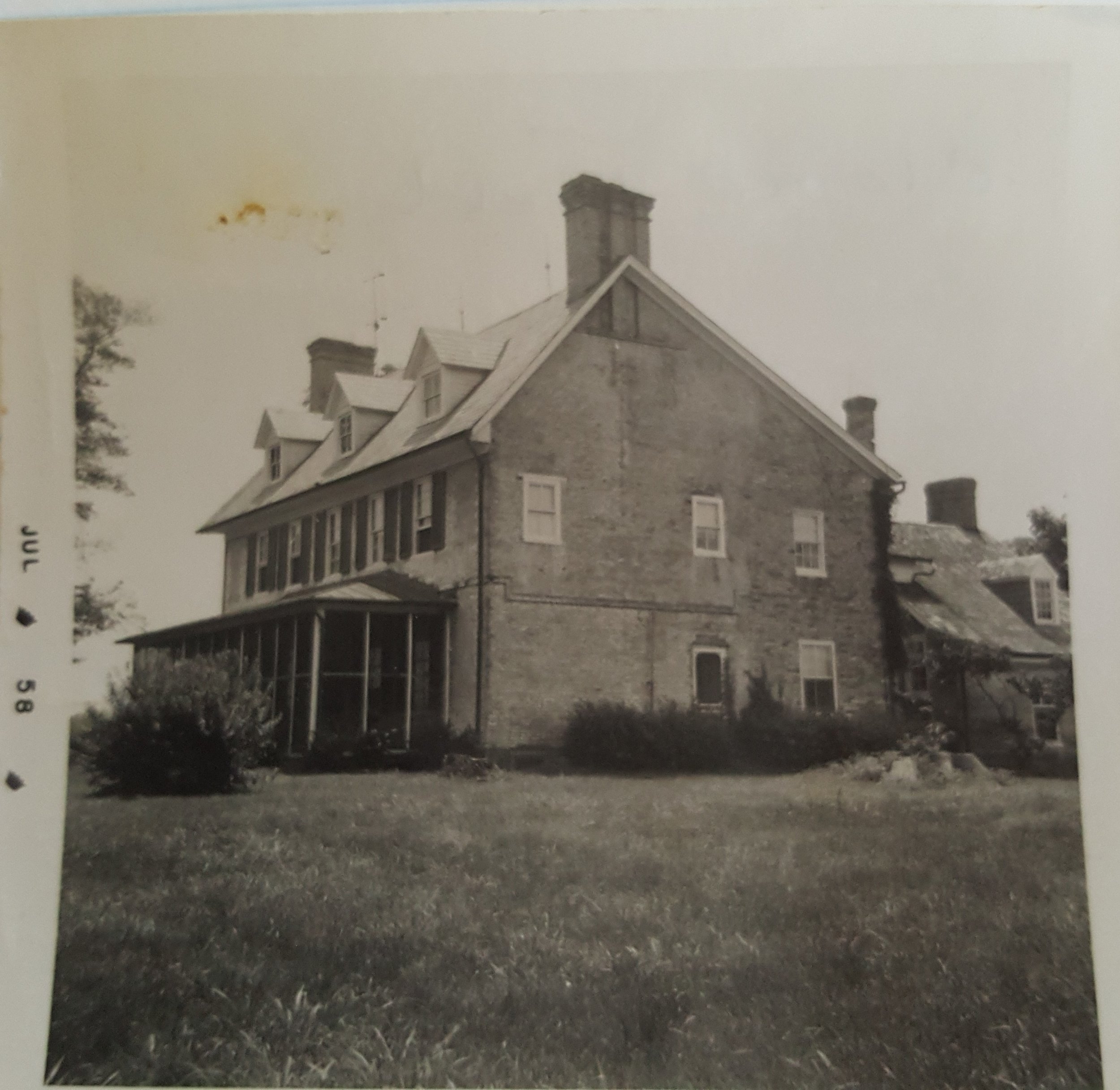Cloverfields as of July 2018: Sisters Raised in the House Bring it to Life, and a Sherd of a Vessel is Identified
/Memories of Former Residents Bring The Historic House to Life
The Cloverfields house was built in 1705. It was owned by descendants of the original owner and their relatives until 1897, when a successful Eastern Shore farmer named Thomas H. Callahan bought it from then owners Frederick Watts Forman and his siblings. The purchase was announced in the October 7th, 1897 edition of the Baltimore Sun. "Sale of A Queen Anne's Farm," reads the title. The short note informs readers that "[t]he farm contains about 300 acres, and is one of the most productive and best situated places in the county." You can see the note below.
An announcement clipped by Sherri Marsh Johns from the October 7, 1897 edition of the baltimore sun.
During the twentieth century, descendants of Mr. Callahan and others related to them lived on the property. Among them we find Mary (Mrs. Pippin) and Elizabeth (Mrs. Brice), featured in the videos above. They are half-sisters, both daughters of Martha, who was first married the son of Mr. Callahan (also called Thomas H.), and then to Mr. Carter. You can see Martha posing in the photograph below.
Martha carter (previously callahan) can be seen above in one of the historic american building survey photos taken in the 1950s. she is the mother of both mary (callahan) pippin and elizabeth (carter) brice.
Mrs. Pippin was born in the house in 1928. In the video above, a ninety-year-old Mrs. Pippin talks with four members of the restoration team: historians Sherri Marsh Johns and Willie Graham, archaeologist Jason L. Tyler, RPA (of Applied Archaeology and History Associates), and project manager Ray Gauthier (of Lynbrook of Annapolis). She identifies several outbuildings on the plans Marsh Johns presents to her. Mrs. Pippin talks about the "chicken house," the "meat house" (where "we hanged the hams and everything"), and the garage. She also discusses the outbuildings with archaeologist Tyler, who finds her insights "really useful."
The highlight of the interview is when Gauthier asks Mrs. Pippin how her parents would feel about the restoration of the parlor. She answers: "I think my mother would be delighted that you all are doing this. I am sure she would have... I am sorry she is not here to see it because she would have loved it." The Foundation would not have been able to do its work if it were not for the fact that Mrs. Pippin's mother, and then Mrs. Pippin and her family, kept and maintained the property. As Graham points out, "that's why we have something serious to work with right now." Gauthier then observes that "it makes all the difference." The fact that they "kept the water out, kept a good roof on" was "an investment in the future." The investment is already starting to produce fruits in terms of historic and archaeological research.
We also interviewed Mrs. Pippin's younger sister, Elizabeth (Carter) Brice. She too was born and raised at Cloverfields, and she also told us about how was life like growing up there. In the video clip above, she recalls her childhood making brine to cure ham. "It was my job," she says, "to take the saltpeter, and the sugar, brown sugar, and hot water." She would stir the mix with an oar until it was ready for the ham. The process took place in what she calls the "summer kitchen." The kitchen once stood off the back of the present-day kitchen, approximately where the concrete block shed addition is today. She remembers the dirt floor -- a detail the archaeologists and historians had speculated about.
The accounts of Mrs. Pippin and Mrs. Brice infuse life into the history of Cloverfields. They contextualize the changes the house underwent since it was purchased by Mr. Callahan. During the more than 100 years during which they owned the property, Mr. Callahan, his descendants and their relatives maintained it and modernized it. They wired the house for electricity, added a new radiator heating system, and replaced locks, flooring, porch, and roof. They also replaced the hyphen with a two story frame structure that included a new dining room and sleeping quarters. They retrimmed the exterior, refashioned the dormers, and covered up the original cornice. They demolished the old kitchen and renovated the back building so as to install a modern stove. They also had several barns and outbuildings built, to serve the farming operation. Much of what stands of Cloverfields today was done in the past century-and-a-half.
The family was also gracious enough to provide the Foundation with the photos you can see below.
The little girl standing in front of the barns is Mrs. Pippin. The photos also depict the changes made to the hyphen, cornice, and landscape.
We cannot overstate how much we appreciate Mrs. Pippin and Mrs. Brice's contribution to the writing of the history of the house. They have been nothing but helpful, sharing with us their time, their stories and their photos.
Rhenish Stoneware Unearthed
The archaeologists continue to analyze the hundreds of artifacts they discovered at Cloverfields during their excavations. One of those artifacts is the ceramic sherd you can see in the photograph below.
Figure 1. Cloverfields rhenish stoneware, gr medallion fragment (left). fragment image to the right illustrates what the complete medallion would have looked like. roughly 2 cm. long.
Archaeologists Alex Glass, MSc and Jeanne A. Ward, RPA, identify the sherds as "Rhenish stoneware," and describe it as follows:
figure 2. ornate george rex medallion with crown, floral sprigs, and winged figure. image courtesy of maryland archaeological conservation lab, diagnostic artifacts of MD, oxonhill site (18pr175).
"Stoneware jugs from this period were used mainly for wine or beer and this jug would likely have been a prized possession of the Hemsley family. Other, less distinctive, fragments of Westerwald have been recovered across the site indicating that the Hemsley family likely owned numerous vessels, as many prominent families of the period (including George Washington at his Ferry Farm property) did (livesandlegaciesblog.org).
While the sherd is small, there is enough of the original design to see that the decoration on it would have been part of a “GR” medallion, the GR abbreviation standing for George Rex, or King George (Fig. 1). These decorations were applied to vessels meant for export from Germany to England and then to her colonies in commemoration of the king. King George I, II, and III ruled successively between 1714- 1820, however, because Rhenish stonewares decline in popularity towards the end of the 18th century it is more likely that this sherd represents the reign of either King George I (1714-1727) or King George II (1727-1760).
figure 3. westerwald stoneware jug with gr medallion (1714-1760). image courtesy of the british museum, online catalog, museum no 1981,1002.33, an1613139899.
The medallion would have been applied by a method known as sprig-molding, where a stamp is used to impress a design on a small piece of clay which is then applied to the vessel wall. Some GR medallions were very ornate featuring crowns, winged figures and swirls (Fig.2). Unfortunately, there isn’t enough of the Cloverfields sherd to say what type of vessel it originates from, but in the Chesapeake, mugs, pitchers, and jugs are found most often (Fig.3)."
For more information on the sherds and other archaeological artifacts, check out the section of our website dedicated to archaeology.
* * *
The Cloverfields Preservation Foundation would like to, once again, thank Mrs. Pippin, Mrs. Brice and their families for their contribution to the telling of the history of Cloverfields. We will continue to develop our friendship with them and other members of the community.
By: Devin Kimmel, AIA, ASLA, for the Cloverfields Preservation Foundation
Photography: Applied Archaeology and History Associates, Willie Graham, and the Callahan, Pippin, Carter and Brice families.
Videos by StratDV Video Production











